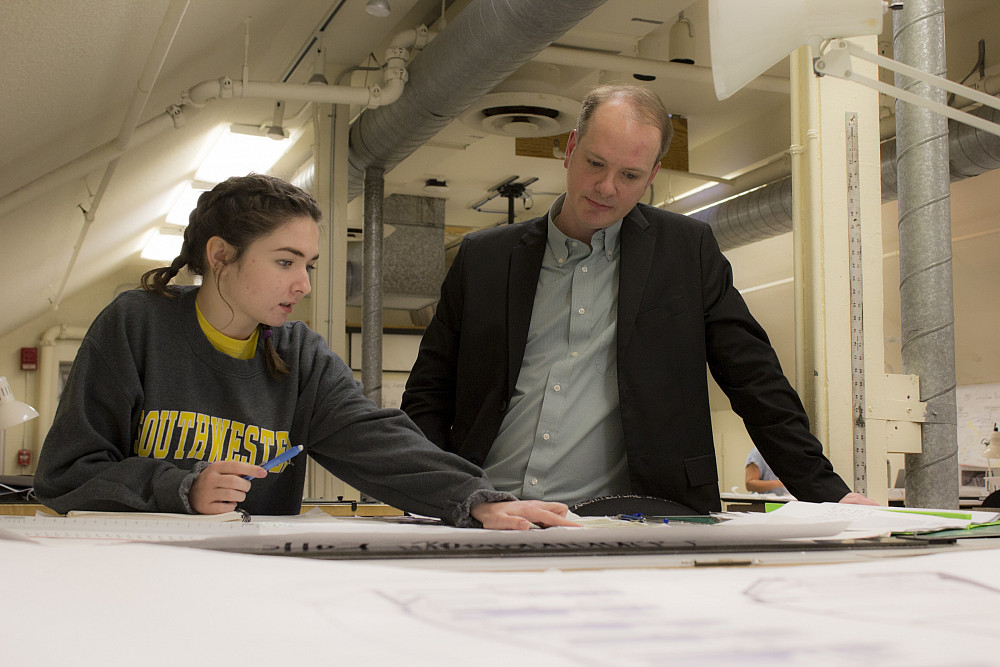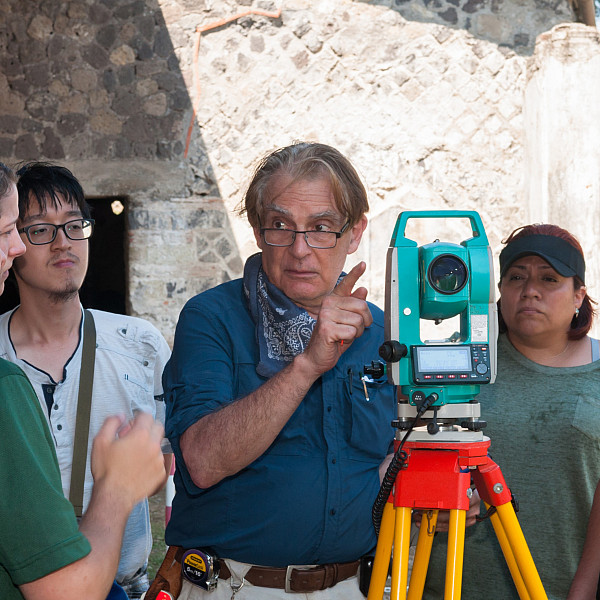News
Building Dreams
March 26, 2019
March 26, 2019

If you ascend the stairs to the architecture studio on the third floor of the Fine Arts Center, you’ll inevitably glimpse a number of posters featuring designs by Julien Meyrat ’98. A senior designer and associate at Gensler, the world-renowned architecture and design firm, Meyrat has played an important design role on a wide range of iconic projects around the globe: his signature is on Legacy West urban village and food hall in Plano and Hope Cottage Pregnancy and Adoption Center in Dallas. In major cities in China, Mexico, and the United Arab Emirates, Meyrat and his colleagues have helped create towers that soar above the skyline and promenades that stretch down sandy beaches or bustling urban districts. Soon, you’ll be able to see his team’s vision realized in glass, steel, stone, and greenery at Indigo Ridge, an “urban oasis” in nearby Cedar Park.
Considering his 16-plus years as a licensed architect, his creative versatility, and his facility with the latest 3-D modeling and digital rendering tools, one might be surprised to learn that Meyrat majored in political science and French at Southwestern. But he is proof of the liberal-arts adage that a student’s field of study does not dictate a particular career path; rather, a degree prepares you for a range of professional pursuits. “The way I saw school was that undergrad was a time to explore, to absorb, to try out different topics and subjects,” he recalls.
He is proof of the liberal-arts adage that a student’s field of study does not dictate a particular career path; rather, a degree prepares you for a range of professional pursuits.
So he first elected a major in political science because he was well-versed in geography and history and was interested in “current events and what was going on in the world.” The French major came from not only his heritage—his father is French, and Meyrat himself was born in Paris—but also his love of reading classic authors as well as a semester studying abroad at the Catholic University of the West, in Angers, France. He also managed to squeeze in several semesters of Chinese as electives—”just for fun,” he admits. As a professional skill, speaking multiple tongues is helpful, he says, “if you’re working in an international practice like architecture. … It always makes a good impression if you try to reach out and speak to them in their language.” But beyond the practical aspects of being able to translate design concepts and working with technical teams across the world, Meyrat values his study of languages more for how it shaped his thought process and perspective. “Learning languages helps you understand different points of view,” he reflects. “It’s helpful as a designer to think outside the box but also to consider different approaches to solving a problem. If you study languages, it trains your mind to think creatively and to arrive at solutions more quickly.”
The power of architecture
Meyrat’s passion for architecture was kindled just before he arrived at Southwestern. During his final year of high school in 1993–1994, he was an exchange student in Germany. More specifically, he was sent to live with a host family in the former German Democratic Republic (a.k.a. East Germany), which had only reunified with the Federal Republic of Germany (a.k.a. West Germany) three years before. Living in a town 20 miles outside Chemnitz, formerly known as Karl-Marx-Stadt, the third-largest city in the Free State of Saxony, young Meyrat observed that even then, “the Soviet sphere and the American theater were very different in terms of freedom, political expression, and, most glaringly, the quality of infrastructure.” The landscape was dotted by shabby and monolithic Soviet architecture and prefabricated concrete slab apartment blocks erected quickly amid the ruins wrought decades earlier by World War II bombing—all of which, he recalls, “had such an impact for me visually. I saw something so monstrous, it made me realize the power of architecture to affect one’s impression and concept of a place.” But Meyrat realized quickly that whether the effects of a design were positive or negative, he could learn from both reactions and make an impact. “Architecture can inspire great feelings, but you also learn what not to do, what to stay away from,” he says. “You know what kind of places make you feel not so great and how to make them better. I like to have a hand in making places better. I wanted to be part of that influence on people.”
“Architecture can inspire great feelings, but you also learn what not to do, what to stay away from. You know what kind of places make you feel not so great and how to make them better. I like to have a hand in making places better. I wanted to be part of that influence on people.”
His desire to study architecture was encouraged by Professor and Chair of Art History Thomas Noble Howe, who lectures in architectural history around the world and leads introductory architectural design studios at Southwestern. “Dr. Howe was a cherished mentor of mine,” Meyrat remembers. “When I was a freshman, I was curious about pursuing architecture as a career because I always had a talent for drawing and illustration. So when I saw in [Howe’s] description that you could major in anything and still get a master’s degree In architecture afterwards, I chose political science and French but also decided to do the architecture and design minor.”
Meyrat would go on to help the SU minor boast its 100% acceptance rate of students admitted to graduate schools in fields ranging from architecture and engineering to industrial design and urban planning: he was accepted to and, in 2002, completed his master of architecture degree at the University of Texas at Austin, then and now a top-10 school in the field. He credits Howe with seeing him through his applications to graduate programs, a process which included assembling a successful portfolio of well-documented drawings, models, and designs from his SU studio courses. Howe’s comprehensive survey courses in architectural history also proved quite valuable, allowing Meyrat to test out of taking all three required history courses at UT and to take on the job as a teaching assistant, in which he immersed undergraduate students in the study of influential movements and notable works of the 20th century. When specifically requested by certain clients today, Meyrat can employ a multitude of historical styles, a skill he thanks Howe for teaching in a studio that is very rarely offered elsewhere.
“A dream factory”
Those of us who are unacquainted with architects might imagine that their work primarily consists of hunkering down over a drafting table, outlining blueprints. However, Meyrat clarifies that although “drawing teaches you how to convey information graphically, helps make sense of a design to builders, and prevents mistakes from happening,” it’s not a talent one must be born with to be a successful architect. Instead, techniques of illustration can be learned, and a lot of it can now be done with the assistance of a computer rather than just by hand.
Well beyond drawing, the daily work of an architect entails developing the initial design and form of a structure, specifying its minute dimensions and details, from height and area to the meticulous placement of its smallest recesses and glazing. The architect’s career requires years of arduous training in internships, and licensed architects are required to demonstrate their extensive knowledge of safety and environmental regulations by keeping their certifications up to date through a lengthy series of exams covering all aspects of planning sites, designing buildings, and understanding their underlying mechanical and structural systems. “We play an important role in ensuring the health, safety, and welfare of [a building’s] occupants,” he explains, “because buildings can fail in various ways—through leaks, mold, fire, or poor on-site execution—that can lead to structural collapse. They can also consume a tremendous amount of energy and resources. So every day, we’re problem-solvers, studying how a site might work or how one can configure spaces to make them work within a specific budget, performing efficiently while maintaining comfort.” Such creative problem-solving is done in collaboration with a large team that also includes owners; civil, structural, and mechanical engineers; landscape architects; contractors; and many other consulting specialists.
Although he continues to be engaged with the routine technical demands of any built project, much of Meyrat’s day-to-day work as a designer centers on responding to a project’s abstract challenges. These include analyzing sites to determine what kinds of structures would best suit those spaces as well as the client’s overall goals, thinking about how a structure will affect its physical setting or how to lay out a public space comprising residential and retail spaces, and strategizing how to combine a range of different functions in a single building. “Every morning, I wake up and have no idea what I’m going to create that day,” he says. “I have to define the problem, and I might have a gut instinct about what should be done or how. Then, I sketch quickly to develop a rough concept, and then I jump on the computer to work it out in a 3-D model”—a digital version of the cardboard models that Meyrat remembers practicing in Howe’s studio courses. “It’s fun because I do a little bit of everything.”

Whether Southwestern molded him or he chose the University because it fit his interests, Meyrat inevitably speaks like a graduate given how he describes the varied interests and perspectives that define his profession: “Architecture is all around us. It’s inescapable. It straddles the worlds of art, math, technology, and engineering. But you choose to do architecture because you love the chance of solving problems in an original way. And those problems that you solve are making an important and positive difference to the people who live in your creations. It’s playing a major role in creating a cultural reality for the people around you.”
Once Howe’s mentee, Meyrat now gives back to Southwestern by lending his own expertise to Howe’s architecture studio students, presenting highlights from his own portfolio before providing feedback on the undergraduates’ building plans and offering suggestions for how to improve. When he speaks about his own projects and engages with these aspiring architects and designers, his enthusiasm becomes contagious. “What gives me so much pleasure is to provide a space that people love, that they’re excited about, that they’re happy to share with friends,” he tells the current students. “It’s this welcoming, good feeling when you know people are coming back here, that they’re making memories here. And I’m proud to be part of the team that brought this wonderful thing to existence. Doctors and lawyers? They have to deal with people’s problems. I work in a dream factory.”
















